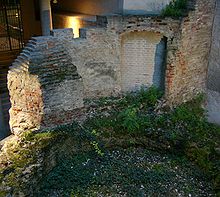Isartor
The Isartor is the eastern city gate of the historic old town of Munich . It was built in 1337 and restored in the neo-Gothic style by Friedrich von Gärtner from 1833 to 1835 . Bernhard Neher added the wall fresco in 1835. The Valentin-Karlstadt-Musäum has been located in the flank towers since 1959 .
location
The Isartor (Tal 50) stands on the border between the Graggenauer Viertel and the Angerviertel at the eastern end of the “ Tal ” street , which is part of the Salzstraße and thus the east-west thoroughfare of the historic old town . The Isartor thus separates the historic old town from the Isarvorstadt and the Lehel . In front of the Isartor is the Isartorplatz, today part of the old town ring .
history

As part of the great city expansion by Ludwig the Bavarian , a second city wall was built from 1285 to 1347 , within the framework of which the Isartor was the last city gate. With the Isartor the fortress works for the necessary defense of the “Outer City”, as the city expansion was called, were completed.
The gate, completed in 1337, consisted of a 40 m high gate tower. Only when the construction of the moat wall the gate tower were the two flanking Steitentürme as Barbican purposed.
The Isartor is almost completely preserved. As the only one of the Munich city gates, it still has the main tower, which as a central tower towers over the entire complex. The flank towers and the courtyard between the main tower and flank towers have also been preserved. The wall between the flank towers now has three gates of the same size instead of the original large archway with two smaller side entrances. In the eastern part of the Mauerhof there is a balustrade facing the courtyard.
The Isartor was, so to speak, the main entrance to the city from the Salzstrasse. Among others, the Roman-German King Maximilian I (HRR) , Emperor Charles V (HRR) in 1530 and King Gustav II Adolf of Sweden moved into the city in 1632 . In 1811 the Isartortheater was built next to the gate. At the beginning of the 19th century, the city council had already decided to demolish the Isar Gate and demolish the walls of the courtyard between the main tower and the side towers. The gate owes its preservation to King Ludwig I , who in 1833 commissioned Friedrich von Gärtner to restore the Isar gate in its historical form. As part of that restoration, the coats of arms on the edge towers and the history of wall frescoes were outside of the internal wall mounted above the doorways that the triumphant Emperor Ludwig of Bavaria for his Battle of Ampfing show in 1,322th The central tower received a clock in 1860 that was originally intended for the central tower of the Karlstor , but after its destruction by a gunpowder explosion it was used for the central tower of the Isar gate.
The Isartor was badly damaged during the Second World War in 1944. From 1946 to 1957, its restoration, which was limited to the most essential backup work, was initially completed. As a result, there were considerable construction defects, and war damage had in some cases only been poorly repaired. A simple tower clock system in the style of the standard station clocks was also installed. In 1971/72 the Isar Gate was renovated, which brought the medieval appearance back to its best advantage and corrected some decisions made during the restoration of 1833. In 1971, for example, the complete tower clock system with the two glass dials and pairs of hands was dismantled in the course of the renovation of the Isar gate and then not reinstalled.
On November 4, 2005, a large clock was again attached to the main tower . On the west side, the dial is a mirror image, accordingly the hands (intentionally) run in opposite directions to remind of Valentin or Bavaria ( Willy Brandt : “In Bavaria the clocks go differently”). On the east side, the clock shows the time in the usual clockwise direction.
Remains of the city fortifications
During the construction of the new administrative center Isartorplatz of the Stadtsparkasse Munich on Thomas-Wimmer-Ring north of the Isartor, remnants of the city wall and the foundation walls of the Prinzessturm , which are now open to the public, were discovered in the mid-1980s . In the same way, remnants of the city wall and the watchtower Lueg are built into the country in houses on Marienstraße , some of which survived the air raids in 1944.
use
The Valentin-Karlstadt-Musäum , where the Café Turmstüberl was set up, has been located in the two flank towers since 1959 .
Isartor S-Bahn station
The Isartor is also the namesake for the Isartor S-Bahn station , which is part of the main S-Bahn line.
literature
- Klaus Gallas : Munich. From the Guelph foundation of Henry the Lion to the present: art, culture, history . DuMont, Cologne 1979, ISBN 3-7701-1094-3 (DuMont documents: DuMont art travel guide).
- Brigitte Huber: walls, gates, bastions. Munich and its fortifications . Volk Verlag, Munich 2015, ISBN 978-3-86222-182-0 , pp. 68-73 .
- Michael Weithmann: Castles in Munich . Stiebner Verlag, Munich 2006, ISBN 3-8307-1036-4 , pp. 130-133 .
Web links
Coordinates: 48 ° 8 ′ 6.4 ″ N , 11 ° 34 ′ 54.1 ″ E



